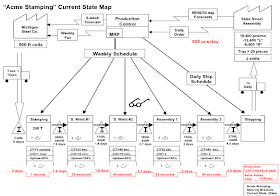After my previous blog publication about
“How to depict the Inventory or the
Process Cycle Times on VSM when those are in parallel? The right way….” http://alexsibaja.blogspot.mx/2014/06/how-to-depict-inventory-or-process.html
.
I have received some question; in regards of “what’s the best way to depict a
process that has many different flows? And how calculate the Lead Time?” Obviously
without any use of VSM Software.
First of all; I always teach to teams the manual method; if you have the
capital to buy VSM software and it’s really needed; buy it and used it.
I understand that in many books about VSM and Lean Manufacturing; there
is the classic example of VSM current state with just one Straight Flow, but we
need understand that the authors of those books (very good books by the way) needs to give a
clear and easy example; to their readers to understand the “Basic Concepts” of
how to create and understand the VSM Current state and see the opportunities
like Waste, Non – Value –Added, Overburden and Unevenness.
Even on some Lean Trainings (some of them very expensive by the
way) always shown a VSM Current State easy and straight flow, but again it’s
for academic purpose.
The problem starts, when you return to your company, to see the
production floor, and you just not have any Idea where to start, because the
real process is very complicated and when you compare it with your training
courses notes (VSM example) it's just doesn't match.
On real life, when you are analyzing a company, the processes may be
very bad with a lot cruises between them, and different process flows that goes
and comes; and you could make the mistake to depict the Current process as in
the books or in the Trainings (just one
straight Flow) and not reflecting the reality; that at the end is the purpose
of the VSM current state, to show the problems.
That’s why I always recommend depict the VSM as one Instantaneous
Picture; as its is; that reflects all the process flows, mix of products, the
comes and goes of products and flows etc. as much as possible. I also recommend
to my teams; to read many books from different authors doesn't matter are from
same subject; the authors experience and the examples can be very different
from each other’s.
Here one example of VSM current state, that is not straight, please see,
how it is draw.
Obviously; now is more complicated calculate the Lead Time right? But
there is an easy way to do it:
Lead Time = [(Total WIP pcs X Takt Time)]+ [Total Cycle
Time]
And must important, practice on real life, forget about, games or
simulations, go to Genba and see real flow, go and see for your self to thoroughly understand the situation (Genchi
Genbutsu).
You can at pictures to VSM if you want.
Then all you need to do is creates the Future VSM, remember; there is
not just one Future State, there are phases.
+23.00.00.png)


+23.01.35.png)
Hi Alejandro,
ResponderBorrarthanks for your presentation.
one question concerning the lead time calculation :
in your previous article, you said, and I agree with, to use the biggest inventory to calculate it, and not to use the sum.
here in your "octupus" VSM exemple, you add all the WIP pcs for the calculation...
I notice however that it is not obvious to identify the biggest inventory(ies) for this cycle.
Thanks in advance for your explanation.
regards
Fabrice
Este comentario ha sido eliminado por el autor.
ResponderBorrarGreat information provided. I appreciate your work....
ResponderBorrarpart time MBA programs in Chandigarh
Industrial engineering chandigarh
Lean Manufacturing certification
Very interesting post. Thanks for sharing it! It is always a joy to learn something that I didn't know. I have you to thank for teaching me something new.
ResponderBorrarsee here my post Lead oxide Manufacturers
Lead Ingots Manufacturers